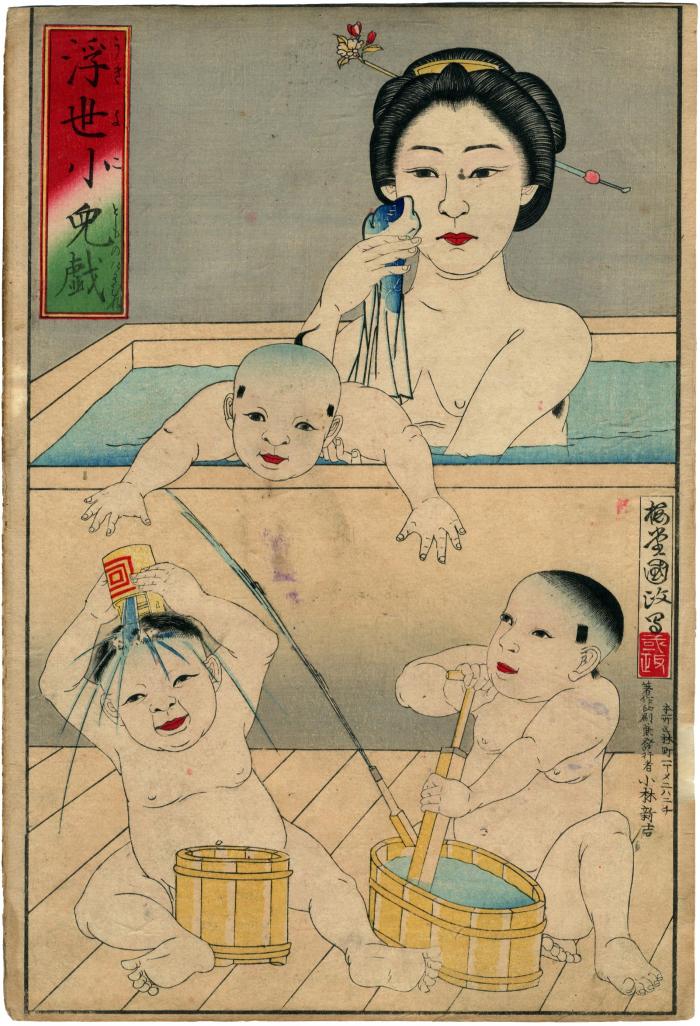Utagawa Kunimasa IV (四代歌川国政) (artist 1848 – 1920)
Hidehisa (family name - 栄久)Kōchōrō (go - 香朝楼)
Takenouchi (original family name - 竹内)
Toyokuni V (五代豊国)
Baidō Hōsai (go - 梅堂豊斎)
Utagawa Kunisada III (三代歌川国貞)
Links
Biography:
A student of Kunisada II. Took the name of Kunisada III in 1889. "Late in life called himself Toyokuni IV, though he was in fact, Toyokuni V. An artist of no importance."
Quoted from Roberts, p. 97.
****
There was an article in the Yomiura shinbun from November 30, 1890 listing the top contemporary artists and their specialties. Kunichika was best known for his actor prints and Kunimasa for his oshi-e (押絵) which are the cloth padded images added to hagoita or battledores. Kunichika was thought to have started his career producing such items.
"Hōsai's career as a designer of actor prints is inextricably linked to the big-league player Kunichika. His accomplishments as a designer of actor prints are often judged against the work of the older artist. However, like Kunichika, his work encapsulated the Utagawa nigao tradition. Different from the more innovative Kunichika, whose art he often emulates, Hōsai rarely veered far from established Utagawa stylistic conventions and palette. A nod to Kunichika is publicly affirmed in a handful of such prints from 1884 with complex settings and a harsh palette, which are signed Toyohara Kunichika naratte Baidō Kunímnsa ga ('Baidō Kunimasa imitating Toyohara Kunichika'..."
"Kunichika and Hōsai were students in the atelier of the enormously popular Kunisada (Toyokuni III, 1786-1864) during the final decades of the Edo period (1600-1868). While their apprenticeship was not concurrent-Kunichika entered Kunisada's studio about a decade before Hōsai in the early 1850s-both artists would have understood their place as part of the larger Utagawa fraternity." In 1898 the Yomiura shinbun started a series of articles on Hōsai in 16 parts. They did one on Kunichika too, but in only 4 parts. In the first installment they said: "He was born in Asakusa and grew up in Nihonbashi. He is an amusíng, unconventional eccentric who designed many nishiki-e zōshi [full-colour woodblock printed materials. Recently, he filled in a lotus pond in Senzoku-chō and has built a modest house. At something of a snail's pace, he has, over time, gradually distinguished himself , thumbing his nose at the world of Meiji tsujin. He is today fifty-four years old and a look at his life is just like reading Ikku's Hizakurige."
Kunimasa was rather young when he entered the studio of the aged Toyokuni III. He said:"I entered the Kameido studio and at that time, well,I didn't learn anything at all about art, instead I mopped the corridor floor or ladled out the water from the wooden bathtub. It was after I came to Hasegawn-chō that I was really taught pictures. Gototei Kunisada died the third year I was with him, and afterwards, because I had already imposed upon the Hasegazua-chō Toyokuni, it was just as though I was entirely his student."
In footnote 17 it says: "It is difficult to know the origins of the name 'Hósai', since neither Kunisada or Kunisada II are thought to have used the name. The slightly younger Kuniaki II (act. c. 1835-88), also a Kunisada student, used the name albeit with different characters. It is probable that the name 'Hōsai' draws the character 'Hō' (another reading of the 'Toyo' of his teacher's name 'Toyokuni') to validate his place within the Toyokuni lineage. Moreover, the artist mentions that he was close to Nezumiya Mankichi. Designers of figurative floats (dashi ningyō) associated with the Nezumiya workshop, active from the Edo to the Taishō periods and producers of floats for such important events like the Kanda or Sannō festivals, included the names Nezumiya Gohei, Takeoka Hōzen, Hōsai, Fukuda Mankichi, etc. Of these, the name 'Hōsai' shares the same characters as the artist. Unfortunately, it cannot be substantiated if there was any link."
"His 'childhood name' (azana) was Chōtarō (the 'chō' is the same character as in the artist's later signature Kōchōrō) and shortly after his birth the family moved to Fukagawa (presentday Kōtō ward). His father, Kineya Teizan (Ōsakaya Eijirō), was a naga-uta performer. Higuchi claims that their family butcher shop, 'Imai', was up until that time still in operation in Fukagawa. Hōsai's mother, Takeuchi Sato, was the daughter of the shogunal retainer Hori Toshihira (1818-60). Her family had greater social clout than Hōsai's father, thus explaining the adoption of his mother's surname. It was apparently through the offices of the father of Utagawa Kunimaro that he was introduced to the kyōgen performer Sakurada Jisuke III, who in turn facilitated Hōsai's entry into the Kunisada studio."
Source and quotes from: 'In the shadow of another. Introducing the 'Meiji no Edokko' Baidō Hōsai' by Amy Reigle Newland, Andon 89, December 2010.
